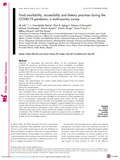| dc.contributor.author | Ali, Jafri | |
| dc.contributor.author | Nonsikelelo, Mathe | |
| dc.contributor.author | Elom, K Aglago | |
| dc.contributor.author | Konyole, Silvenus O | |
| dc.contributor.author | Moussa, Ouedraogo | |
| dc.contributor.author | Keiron, Audain | |
| dc.contributor.author | Zongo, Urbain | |
| dc.contributor.author | Laar, Amos K | |
| dc.contributor.author | Jeffrey, Johnson | |
| dc.contributor.author | Sanou, Dia | |
| dc.date.accessioned | 2022-01-10T09:36:33Z | |
| dc.date.available | 2022-01-10T09:36:33Z | |
| dc.date.issued | 2021-03-05 | |
| dc.identifier.uri | https://doi.org/10.1017/S1368980021000987 | |
| dc.identifier.uri | https://www.cambridge.org/core/journals/public-health-nutrition/article/food-availability-accessibility-and-dietary-practices-during-the-covid19-pandemic-a-multicountry-survey/8F46F4718976924C0191582A07C8DCAD | |
| dc.identifier.uri | http://ir-library.mmust.ac.ke:8080/xmlui/handle/123456789/2002 | |
| dc.description.abstract | Objective: To investigate the perceived effects of the coronavirus disease (COVID-19) pandemic lockdown measures on food availability, accessibility, dietary practices and strategies used by participants to cope with these measures.
Design: We conducted a cross-sectional multi-country online survey between May and July 2020. We used a study-specific questionnaire mainly based on the adaptation of questions to assess food security and coping strategies from the World Food Programme's 'Emergency Food Security Assessment' and 'The Coping Strategy Index'.
Setting: The questionnaire was hosted online using Google Forms and shared using social media platforms.
Participants: A total of 1075 adult participants from eighty-two countries completed the questionnaire.
Results: As a prelude to COVID-19 lockdowns, 62·7 % of the participants reported to have stockpiled food, mainly cereals (59·5 % of the respondents) and legumes (48·8 %). An increase in the prices of staples, such as cereals and legumes, was widely reported. Price increases have been identified as an obstacle to food acquisition by 32·7 % of participants. Participants reported having lesser variety (50·4 %), quality (30·2 %) and quantity (39·2 %) of foods, with disparities across regions. Vulnerable groups were reported to be facing some struggle to acquire adequate food, especially people with chronic diseases (20·2 %), the elderly (17·3 %) and children (14·5 %). To cope with the situation, participants mostly relied on less preferred foods (49 %), reduced portion sizes (30 %) and/or reduced the number of meals (25·7 %).
Conclusions: The COVID-19 pandemic negatively impacted food accessibility and availability, altered dietary practices and worsened the food insecurity situation, particularly in the most fragile regions. | en_US |
| dc.language.iso | en | en_US |
| dc.publisher | Cambridge University Press | en_US |
| dc.subject | Food, availability, accessibility, dietary, practices, during, COVID-19, pandemic, multi-country, survey | en_US |
| dc.title | Food availability, accessibility and dietary practices during the COVID-19 pandemic: a multi-country survey | en_US |
| dc.type | Article | en_US |

